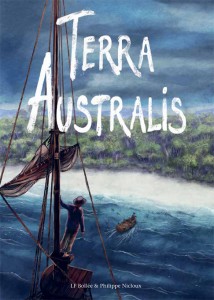Terra Australis
by LF Bollée and Philippe NiclouxTo begin with, the legend goes something like this: a nation born from a shipful of convicts. A gaggle of criminals sentenced to transportation who washed up onshore, knowing neither how nor why, who settled largely hostile territories and wound up staying, all while disregarding the indigenous peoples there already. A bit vague as stories go, isn’t it? And all the more paradoxical given how recent it is. As the Bastille was stormed on 14 July 1789, there were barely a thousand people and a handful of improvised dwellings above the beach that today is Sydney Ferry Terminal. What were those people doing there? Why had they been sent to Botany Bay? How did cohabitation with the ‘natives’ (not yet known as aborigines) really go down; who was in charge and how did they get organised? So many questions we largely ignore, so many answers to supply. Even if that far corner of the earth was called Terra Australis Incognita, from 1770 to 1791 it was an irresistible magnetic pole, a veritable social, political, and geographical black hole, drawing and focusing all humanity’s energies. The face of the world changed, and the Pacific was its mirror, in which it suddenly no longer recognised itself.
I don’t know who the good guys were, the bad guys, the torturers, the victims, the saints, the demons. All I know is that men are weak and unjust, capable of the noblest impulses and the darkest thoughts.”
Let me say up front: I don’t know who the good guys were, the bad guys, the torturers, the victims, the saints, the demons. All I know is that men march forward and seldom take the time to look around them. I know they are weak and unjust, capable of the noblest impulses and the darkest thoughts. I know that wherever they go, they carry within them the deadliest diseases and the deepest doubts. I suppose it is in their essence to do wrong, and in their nature to regret it. I think we can try and plumb the depths of their souls.
Terra Australis was born in December 2007. A cliff walk on Phillip Island, south of Melbourne. Flies by the dozen, buzzing in air fanned by warm winds, and in my non-stop attempts to fend them off, a thought crept in: Phillip Island… wait a minute, just who is Phillip?
Arthur Phillip (1738–1814), naval officer, commander of the First Fleet, first English governor of New South Wales. One year of reading and research to find out more, to begin to understand the individuals, groups, subgroups, ramifications, relations, chronologies, events. An initial 800-page draft that had to be cut, painfully…
One day, I was told a certain Philippe Nicloux had written a letter proposing himself as the artist for the book. I never knew how he found out, and how he got the crazy idea into his head, but I wasn’t going to complain. A field test of four pages was given to him. Four pages isn’t much, right? Still, I admit it was too early for me, I hadn’t finished tinkering with the book’s structure. I wrote a short sequence sure to make it into the final draft: the departure of the fleet from Portsmouth at dawn on 13 May 1787, featuring a wigless Arthur Phillip with butterflies in his stomach at the challenge awaiting him. I have always maintained that he must have been dying of fear and anxiety as he was leaving; he must have smacked his forehead on the table where he was sitting and said something like, “God give me strength!” But the mise-en-scène still had a long way to go. To make a long story short, Philippe drew the sequence, and I was… disappointed. Disappointed because I saw my layouts weren’t appropriate for a graphic novel whose rhythm would naturally be unusual. Disappointed because Philippe presented me with my own failure, and it was also a way of saying that his art needed more, deserved better.
But I instantly understood that only Philippe Nicloux could draw Terra Australis, and that we would soon be setting sail together. That flamboyant black line; those faces, sometimes deformed but ever so expressive; those figures, forceful and fragile at once; and those great shivering trees, those menacing hulks, those buffeted boats and mysterious forests that I had unconsciously been waiting for right from the story. Philippe would bring these all to me, things both vanished and still living, backdrops intimate and grandiose, characters big and small, atmospheres dark and bloody.
LF Bollée, from the introduction to Terra Australis, published by SelfMadeHero. Translation by Edward Gauvin.
Read more.
 Laurent-Frédéric Bollée is a journalist and the author of over 40 graphic novels. He lives in Versailles.
Laurent-Frédéric Bollée is a journalist and the author of over 40 graphic novels. He lives in Versailles.
Philippe Nicloux is from Nice and has previously illustrated three graphic novels for French publishing house Les Enfants Rouges.

